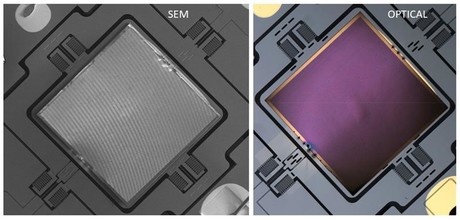Metalenses for MEMS chips

US researchers have developed a new type of lens using standard computer-chip technology that could replace the bulky layers and complex geometries of traditional curved lenses.
Lens technologies have advanced in recent years across all scales, from digital cameras and high bandwidth in fibre optics to the LIGO lab instruments. Flat lenses, for example, are relatively lightweight, and based on optical nanomaterials known as metasurfaces. When the subwavelength nanostructures of a metasurface form certain repeated patterns, they mimic the complex curvatures that refract light, but with less bulk and an improved ability to focus light with reduced distortion. However, most of these nanostructured devices are static, which limits their functionality.
Harvard University physicist Federico Capasso, a pioneer of metalens technology, recently teamed up with Daniel Lopez from Argonne National Laboratory, an early developer of microelectromechanical systems (MEMS) — a circuit-based technology that incorporates microelectronics (like those found in computer chips) and includes mechanical microstructures like actuators and gears. The scientists were considering adding motion capabilities like fast scanning and beam steering to metalenses for new applications.
Found in everything from smartphones to airbags, biosensing devices, appliances and optics, MEMS are fabricated using the same techniques used for integrated circuits on typical computer chips. Together, Capasso and Lopez developed a device that integrates mid-infrared spectrum metalenses onto MEMS, with the results published in the journal APL Photonics.
“Dense integration of thousands of individually controlled lens-on-MEMS devices onto a single silicon chip would allow an unprecedented degree of control and manipulation of the optical field,” Lopez said.
The researchers formed the metasurface lens using standard photolithography techniques on a silicon-on-insulator wafer with a 2 µm-thick top device layer, a 200 nm buried-oxide layer and a 600 µm-thick handle layer. Then they placed the flat lens onto a MEMS scanner, essentially a micromirror that deflects light for high-speed optical path length modulation. They aligned the lens with the MEMS’s central platform and fixed them together by depositing small platinum patches.
“Our MEMS-integrated metasurface lens prototype can be electrically controlled to vary the angular rotation of a flat lens and can scan the focal spot by several degrees,” Lopez said. “Furthermore, this proof-of-concept integration of metasurface-based flat lenses with MEMS scanners can be extended to the visible and other parts of the electromagnetic spectrum, implying the potential for application across wider fields, such as MEMS-based microscope systems, holographic and projection imaging, LIDAR (light detection and ranging) scanners and laser printing.”
When electrostatically actuated, the MEMS platform controls the angle of the lens along two orthogonal axes, allowing the scanning of the flat lens focal spot by about 9° in each direction. The researchers estimate that the focusing efficiency is about 85%.
“Such metalenses can be mass produced with the same computer-chip fabrication technology and, in the future, will replace conventional lenses in a wide range of applications,” Capasso said.
Ultra-thin cooling solution for mobile devices
Scientists have developed an innovative cooling device — an ultra-thin loop heat pipe...
Scientists unveil flexible OLED panel with built-in speaker
Researchers have developed a smartphone-sized OLED display that can change its shape and act as a...
A multimodal light manipulator
A new interferometer could replace beam-splitting waveguides for fibre-optics.





